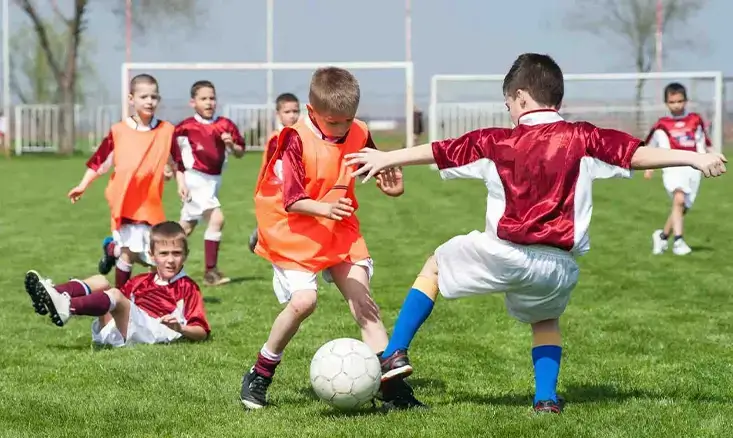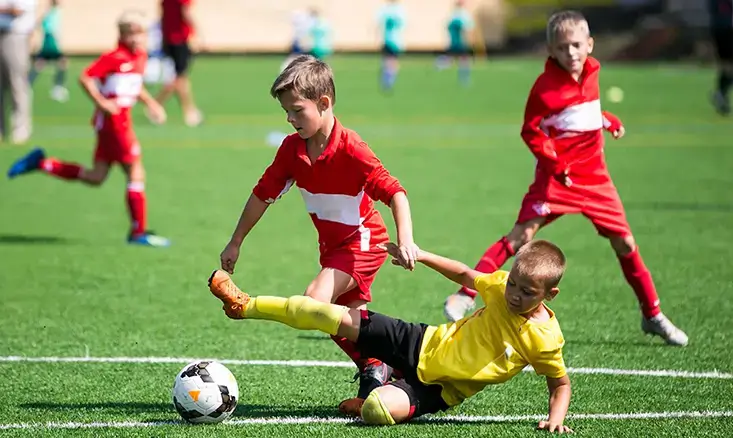Understanding Youth Soccer Fouls and Misconduct: A Comprehensive Guide for Players, Coaches, and Parents

CRFC BLOGS
LATEST BLOGS & NEWSLETTERS
Understanding Youth Soccer Fouls and Misconduct: A Comprehensive Guide for Players, Coaches, and Parents
Youth soccer is more than a sport—it’s a space for young players to grow as individuals, develop teamwork skills, and learn important life values. However, every participant must understand the game’s rules to ensure fair play and safety. A critical part of these rules revolves around youth soccer fouls and misconduct. These concepts are essential for creating a positive and respectful environment on the field.
What Are Youth Soccer Fouls and Misconduct?
Defining Youth Soccer Fouls
In youth soccer, fouls are actions that break the game’s rules during play. They often occur unintentionally as young players develop their skills and understanding of the game. Referees are trained to manage these situations with a balance of discipline and guidance, ensuring players learn from their mistakes.
Understanding Misconduct in Youth Soccer
Misconduct in youth soccer means actions that go against the rules or show disrespect for the game. This includes unsporting behavior, dissent, or repeated violations. Referees often rely on youth soccer misconduct codes to address such violations.
Teaching young players to respect the game and its officials is vital to their development. Misconduct is addressed not only with penalties but also with opportunities for players to learn and grow.
Common Youth Soccer Fouls
Understanding the common violations helps players, coaches, and parents make a better game environment.
Physical Fouls
Physical fouls are the most common type in youth soccer. These include:
Kicking or Tripping
Often resulting from poorly timed tackles or overexcited play.
Reckless Tackling
Tackling an opponent without regard for their safety.
Pushing
Using excessive force to push or collide with an opponent.
These fouls can lead to injuries, making it crucial for young players to learn proper techniques.
Technical and Tactical Fouls
These fouls are less about physical contact and more about breaking specific rules of youth soccer:
Deliberate Handball
Using the hands or arms to block or control the ball illegally.
Obstruction
Interfering with an opponent’s movement without playing the ball.
Dangerous Play
Actions like high kicks that put another player at risk.
Referees may use these moments as teaching opportunities, emphasizing the importance of fair play.

Misconduct in Youth Soccer
Misconduct in youth soccer can arise from emotional responses or a lack of understanding of the game’s rules. Addressing these behaviors constructively helps players develop sportsmanship.
Types of Misconduct in Youth Soccer
Unsporting Behavior
This includes actions that show a lack of respect for the game or other participants. Examples include:
- Pretending to be fouled (diving) to deceive the referee.
- Wasting time intentionally to gain an advantage.
- Overly aggressive celebrations that disrupt the game.
Repeated Rule-Breaking
When a player repeatedly commits fouls despite warnings. This can disrupt the flow of the game and lead to penalties.
Dissent by Word or Action
Young players may argue with referees or express frustration through disrespectful gestures. Teaching them to manage their emotions respectfully is an important part of their growth as athletes.
Leaving the Field Without Permission
Players are expected to remain on the field unless instructed otherwise by the referee. Leaving without permission disrupts the game and can be penalized.

Penalties for Fouls and Misconduct in Youth Soccer
Referees enforce penalties to maintain order and fairness in youth soccer. These penalties not only address the infraction but also provide learning opportunities for young players.
Penalties for Youth Soccer Fouls
Free Kicks
Free kicks are awarded to the opposing team after a foul. They can be:
- Direct Free Kick: Allows the kicker to attempt a goal directly, usually for serious fouls.
- Indirect Free Kick: This requires the ball to touch another player before a goal can be scored. It is often awarded for technical fouls.
Penalty Kicks
A penalty kick is awarded for fouls committed inside the penalty area. It provides the opposing team with a direct and uncontested shot at goal.
Penalties for Misconduct in Youth Soccer
Yellow Cards
A yellow card cautions against actions like unsporting behavior or dissent. Two yellow cards in one game result in a red card.
Red Cards
A red card results in the immediate dismissal of the player from the game. This is issued for serious offenses like violent conduct or offensive language. Teams must continue with one fewer player, emphasizing the importance of discipline.
Role of Referees in Youth Soccer
Referees are central to enforcing rules and teaching young players about fair play.
Challenges in Officiating Youth Soccer
Referees face unique challenges when Refereeing youth soccer:
Skill Development
Young players are still mastering techniques, leading to unintentional fouls.
Emotional Maturity
Players may react impulsively to decisions they find unfair.
By addressing these challenges with patience and clear communication, referees ensure that the game remains a learning experience.

Teaching Youth Players About Fouls and Misconduct
Education is key to minimizing fouls and misconduct in youth soccer. Players, coaches, and parents each have a role to play.
For Players
Young players should focus on learning the basics of the game, including the consequences of fouls and misconduct. Showing respect for referees and opponents helps them grow as individuals.
For Coaches
Coaches play the leading role in shaping players’ understanding of the rules. They can use moments of misconduct as teaching opportunities to emphasize the importance of sportsmanship and discipline.
For Parents
Parents can support players by modeling respectful behavior during games. Encouraging effort and fair play over winning develops the correct values in young players.
Benefits of Understanding Youth Soccer Fouls and Misconduct
Learning the rules of youth soccer fouls and misconduct benefits players in several ways:
Safety
Following the rules reduces the risk of injuries.
Respect
Understanding and respecting the rules build positive relationships among players, referees, and opponents.
Life Skills
The discipline and teamwork learned through soccer extend to other areas of life, preparing players for future challenges.

Conclusion
Understanding youth soccer fouls and misconduct is essential for ensuring a safe, fair, and enjoyable experience on the field. Educating players, coaches, and parents about these rules can create an environment that values respect, sportsmanship, and growth. Youth soccer is not just about competition—it’s about fostering qualities that young athletes will carry for a lifetime.
FAQs
What are common fouls in youth soccer?
Common fouls in youth soccer include kicking, tripping, pushing, and holding opponents. These often happen as players learn the game, and referees address them to keep the match safe and fair.
What is considered misconduct in youth soccer?
Misconduct includes unsporting behavior, arguing with referees (dissent), and repeated fouling. Referees use yellow and red cards to manage these behaviors and teach young players about sportsmanship.
What are the penalties for fouls in youth soccer?
If committed in the penalty area, fouls can result in free kicks (direct or indirect) or penalty kicks. These penalties help enforce fairness and create learning opportunities for players.
How do referees manage fouls and misconduct in youth soccer?
Referees enforce the rules using warnings (yellow cards) and dismissals (red cards). They also balance discipline with guidance to help young players understand the importance of following the rules.
Why is teaching kids about fouls and misconduct in youth soccer important?
Teaching kids about fouls and misconduct helps them play safely, respect the game, and develop life skills like teamwork, discipline, and accountability—values they carry beyond the field.

Did you find this useful?


